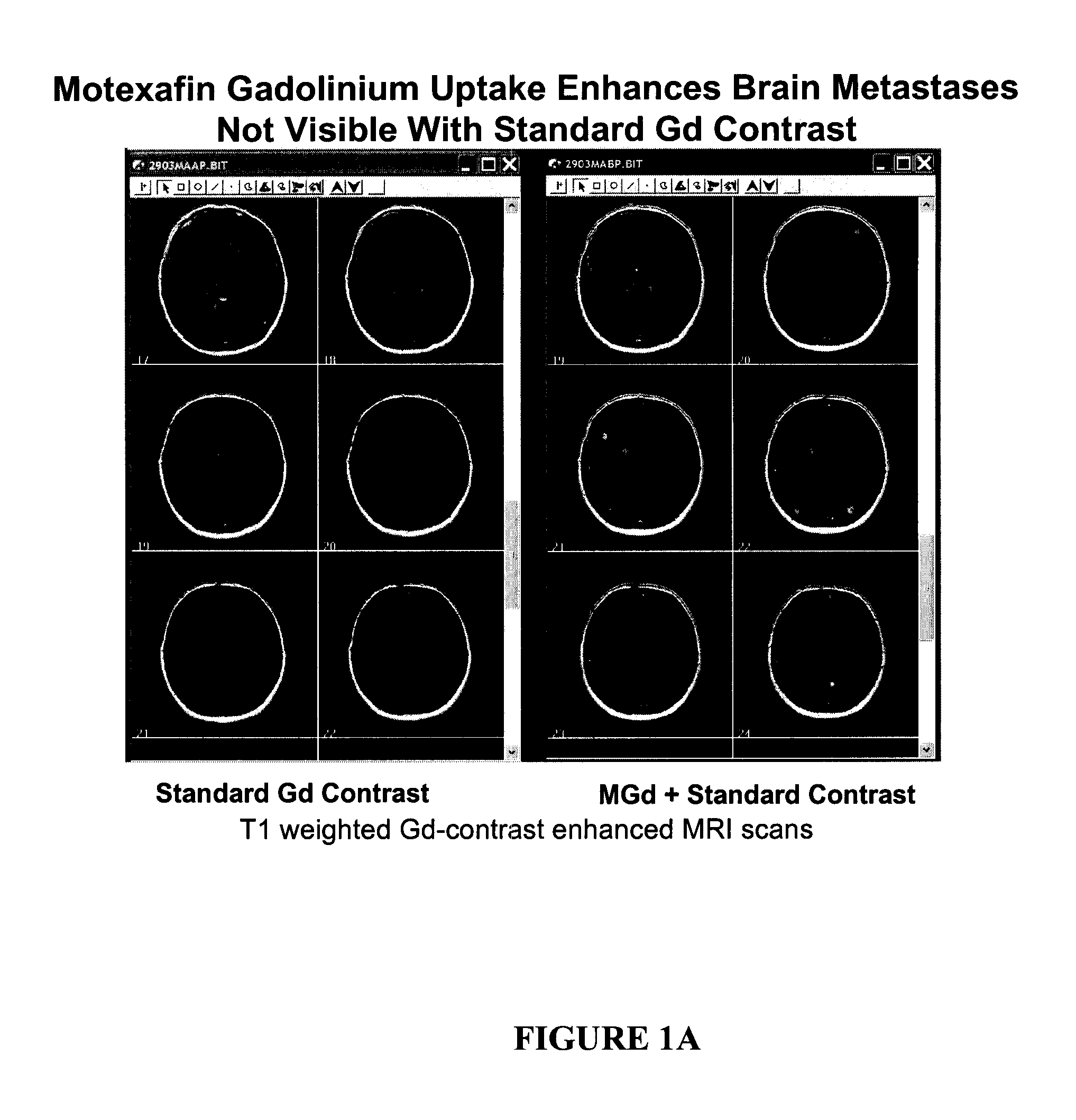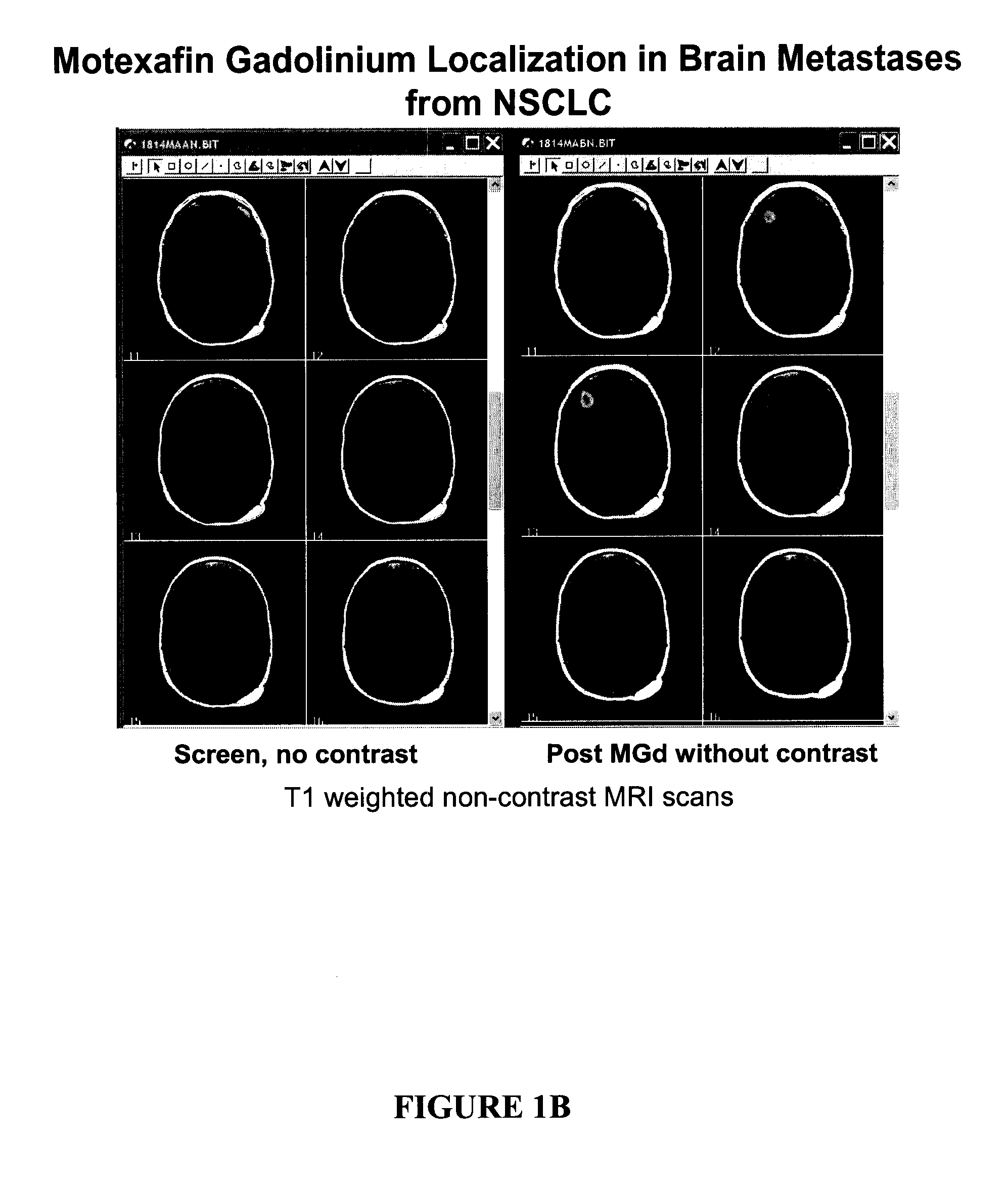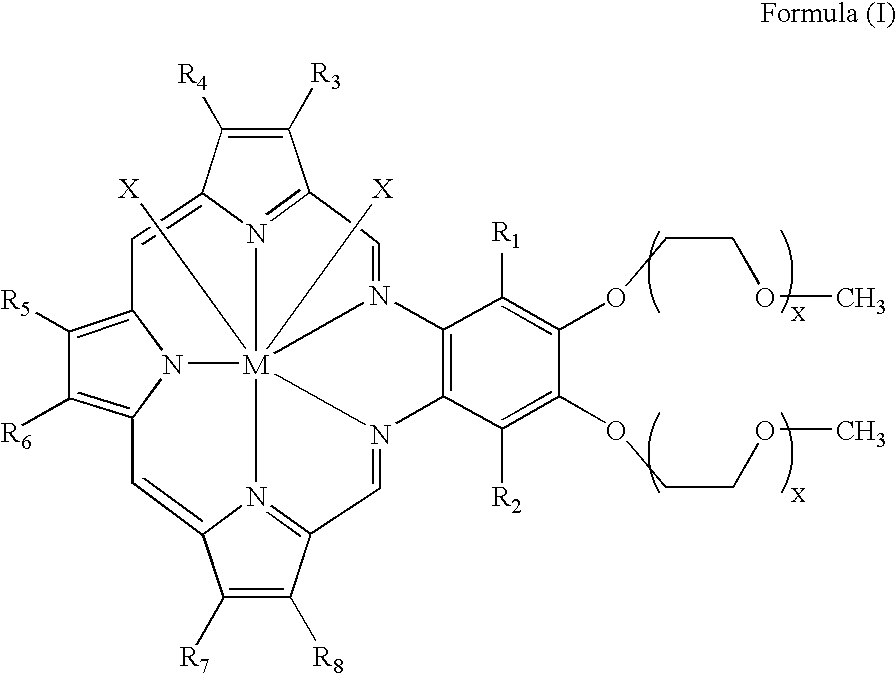[0009] In some embodiments, the patient has further received at least one
dose of a non-texaphyrin
gadolinium complex at least once in the three weeks prior to SRS. In some embodiment, the patient has received
radiation therapy WBRT at least once in the three week period prior to SRS. In some embodiments, at least one texaphyrin-metal complex is MGd. In some embodiments, the texaphyrin-metal complex is MGd. In some embodiments, the cancer is brain metastases and the patient exhibits 1 to 4 brain metastases from a
solid tumor. In some embodiments, the
improved method provides increased image brightness of at least one
lesion. In some embodiments, the
improved method provides increased image sensitivity of at least one
lesion. In some embodiments the
improved method provides increased image accuracy for at least one
lesion. In some embodiments, the improved method detects at least one additional lesion. In some embodiments, the improved method provides increased
lesion identification. In some embodiments, the improved method provides increased lesion location. In some embodiments, the improved method provides increased lesion perimeter location.
[0014] In a further or alternative embodiment, the high-purity texaphyrin-metal complexes is Motexafin
Gadolinium (MGd). In a further or alternative embodiment, the patient is further administered at least one
dose of a non-texaphyrin
gadolinium complex. In a further or alternative embodiment, the MGd is administered at least 4 hours prior to receiving at least 10 Gy to at least one lesion. In a further or alternative embodiment, the patient has been administered multiple doses of MGd in the three weeks prior to receiving at least 10 Gy to at least one lesion. In a further or alternative embodiment, at least five doses of MGd have been administered in the three weeks prior to receiving at least 10 Gy to at least one lesion. In a further or alternative embodiment are methods further comprising the step of providing hyperfractionated
radiation therapy on the patient. In a further or alternative embodiment, the hyperfractionated
radiation therapy is whole brain radiation therapy (WBRT), wherein the WBRT in administered over 6-50 days. In further or alternative embodiments the hyperfractionated radiation therapy is stereotactic
radiosurgery (SRS), wherein the SRS is administered (for example) over 2 days, in 3 days, in 4 days, in 5 days, in 6 days, in 7 days. In a further or alternative embodiment are methods further comprising the step of providing hypofractionated radiation therapy on the patient. In a further or alternative embodiment, the hypofractionated radiation therapy is whole brain radiation therapy (WBRT), wherein the WBRT in administered over 1-5 days. In further or alternative embodiments the hypofractionated radiation therapy is stereotactic radiosurgery (SRS), wherein the SRS is administered (for example) over 1 day. In a further or alternative embodiment, the at least 10 Gy of radiation is provided by stereotactic radiosurgery. In a further or alternative embodiment, the high-purity texaphyrin-metal complex or a pharmaceutically acceptable derivative is administered prior to each time the patient receives hyperfractionated radiation therapy. In a further or alternative embodiment, the patient receives MGd during the second and third week of treatment of WBRT. In a further or alternative embodiment, the patient receives a total of about 30 to about 50 Gy of radiation during WBRT. In further or alternative embodiment, the patient receives a total of about 35 to about 40 Gy of radiation during WBRT. In a further or alternative embodiment, the patient receives at least about 15 Gy of radiation to at least one lesion. In a further or alternative embodiment, about ten doses of MGd in an amount of up to about 5 mg / kg is administered daily during the second and third week of treatment of WBRT. In a further or alternative embodiment, the cancer's size is reduced by at least about 50%. In a further or alternative embodiment, radiological progression in the patient is reduced by at least about 50%. In a further or alternative embodiment, the patient exhibits about 1 to 4 brain metastases from a
solid tumor. In a further or alternative embodiment, neurological progression in the patient is reduced by at least about 50%.
[0023] In a further or alternative embodiment, the MGd is administered prior to performing the stereotactic radiosurgery on the patient. In a further or alternative embodiment, further comprising the step of performing
external beam radiation therapy on the patient. In a further or alternative embodiment, the MGd is administered prior lo the patient undergoing
external beam radiation therapy. In a further or alternative embodiment, the brain metastases' size is reduced by at least about 50%. In a further or alternative embodiment, neurological progression in the patient is reduced by at least about 50%. In a further or alternative embodiment, radiological progression in the patient is reduced by at least about 50%.
[0039] Another aspect relates to an improved method for treating cancer in a patient undergoing radiation therapy, wherein the improvement is administering an effective amount of at least one texaphyrin-metal complex or a pharmaceutically acceptable derivative before the patient receives stereotactic radiosurgery. In some embodiments, the patient receives the texaphyrin-metal complex at least about 4 hours prior to receiving stereotactic radiosurgery; at least about 3 hours prior to receiving stereotactic radiosurgery; at least about 2 hours prior to receiving stereotactic radiosurgery. In some embodiment, the radiation therapy includes WBRT. In some embodiments, at least one texaphyrin-metal complex is MGd. In some embodiments, the texaphyrin-metal complex is MGd In some embodiments, the cancer is brain metastases and the patient exhibits 1 to 4 brain metastases from a
solid tumor. In some embodiments, the brain metastases' size is reduced by at least about 50%. In some embodiments, neurological progression in the patient is reduced by at least about 50%. In some embodiments, radiological progression in the patient is reduced by at least about 50%.
[0043] Another aspect relates to an improved method for defining the image and
treatment field for stereotactic radiosurgery, wherein the improvement is administering an effective amount of at least one texaphyrin-metal complex or a pharmaceutically acceptable derivative before the patient receives stereotactic radiosurgery. In some embodiments, the patient receives the texaphyrin-metal complex at least about 4 hours prior to receiving stereotactic radiosurgery; at least about 3 hours prior to receiving stereotactic radiosurgery; at least about 2 hours prior to receiving stereotactic radiosurgery. In some embodiments, the patient has received at least 5 doses of the texaphyrin metal complex in the three week period prior to SRS; at least 7 doses of the texaphyrin metal complex in the three week period prior to SRS; at least 10 doses of the texaphyrin metal complex in the three week period prior to SRS. In some embodiments, the patient has further received at least one
dose of a non-texaphyrin
gadolinium complex at least once in the three weeks prior to SRS. In some embodiment, the patient has received radiation therapy WBRT at least once in the three week period prior to SRS. In some embodiments, at least one texaphyrin-metal complex is MGd. In some embodiments, the texaphyrin-metal complex is MGd. In some embodiments, the cancer is brain metastases and the patient exhibits 1 to 4 brain metastases from a
solid tumor. In some embodiments, the improved method provides increased image brightness of at least one lesion. In some embodiments, the improved method provides increased image sensitivity of at least one lesion. In some embodiments, the improved method provides increased image accuracy for at least one lesion. In some embodiments, the improved method detects at least one additional lesion. In some embodiments, the improved method provides increased
lesion identification. In some embodiments, the improved method provides increased lesion location. In some embodiments, the improved method provides increased lesion perimeter location.
[0066] In this procedure, a physician will first determine the location, size, shape, and volume of the tumor, metastases, lesion, or
abnormality using conventional
visualization techniques, such as
magnetic resonance imaging (MRI),
computed tomography (CT) scan, and / or a
catheter angiogram. To facilitate targeted delivery of radiation beams, in some forms of SRS, the afflicted area of the body is immobilized and marked. Immobilization devices which provide means to mark particular areas of the body have been used to assist in targeting administration of radiation beams. See, for example, Bentel, G. C., Treatment Geometry,
Patient Positioning and Immobilization in
Radiation Oncology, McGraw-Hill Publishers, p. 1-10 (1999), Bentel, G. C., Treatment
Accuracy and Precision,
Patient Positioning and Immobilization in
Radiation Oncology, McGraw-Hill Publishers, p. 11-22 (1999); Bentel, G. C., General Consideration of Positioning and Immobilization
Patient Positioning and Immobilization in Radiation
Oncology, McGraw-Hill Publishers, p. 23-37 (1999); and Bentel, G. C.,
Central Nervous System, Patient Positioning and Immobilization in Radiation Oncology, McGraw-Hill Publishers, p. 71-91 (1999). Head frames, which optionally have three-dimensional coordinates built in and can be attached to the
skull with four screws, have also been used as guiding devices to ensure that radiation beams are focused exactly and only at positions where treatment is needed. Alternatively, some SRS systems use bony landmarks or beads in the ears and don't require immobilization of the patient.
 Login to View More
Login to View More 


